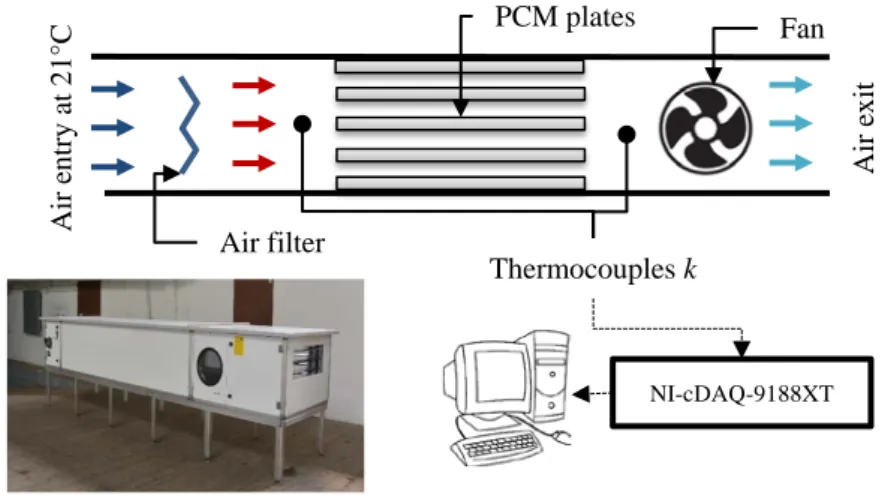DEVELOPMENT AND PRELIMINARY EVALUATION OF
PCM THERMAL ENERGY STORAGE FOR AIR COOLING
IN BUILDINGS
P. PONTELANDOLFO1, P. HAAS1, R. DA SILVA LIMA1, R. PUTZU1, O. SARI2, P. NIKKOLA2 1 University of Applied Sciences and Arts Western Switzerland, HEPIA-Genève, Switzerland
2 University of Applied Sciences and Arts Western Switzerland, HEIG-VD, Switzerland ABSTRACT
This study presents the development of a real-scale latent heat thermal energy storage device based on an air-PCM (phase change material) heat exchanger. The device uses the outdoor ambient temperature difference between night and day to refresh the indoor air and shift or completely avoid the use of air-conditioning in air-cooling in the building sector. The design is based on an extensive set of numerical simulations, performed by the commercial software ANSYS Fluent®, focused on a parametric study allowing to identify the optimum value of different design parameters in order to have 10 hours of temperature shift. The numerical simulations were supported by experimental measurements done with a small-scale test rig. Additionally, the thermal response of the PCM to cooling and heating was also studied in a controlled temperature and humidity environment.
Keywords: Thermal energy storage, Phase change material (PCM), Prototype development and realisation, Buildings, CFD Simulations.
1 INTRODUCTION
The energy demand due to air-conditioning in buildings is a big issue for the electrical distribution in a city [1]. The reduction of the energy consumption and the improvement of the existing methods to store energy are crucial nowadays. The use of Thermal Energy Storage (TES) device to refresh the indoor air of a building can decrease the use of air-conditioning and, generally, enhance the energy efficiency of buildings [2].
TES for building cooling have been classified as active or passive [3]. The use of active TES gives a high control on the indoor conditions. This kind of system contains mechanically assisted components which create interactions between the system and the energy source. On the other hand, in a fully passive TES the thermal exchange between system and source is provided only by natural phenomena without any external device. Passive TES systems maintain the comfort conditions in buildings and minimize the use of mechanically assisted heating or cooling systems. The present work is the design of a passive thermal storage device with a minimal use of external devices.
It is well know that it can be possible to create a temperature shift between entry and exit of a passive TES [4, 5, 6, and 7]. In normal conditions, the temperature during the day changes from a minimal value, which is normally measured during the night, to a maximal value, which is normally measured during the day, and they are shifted of around 12 hours. M. Zgraggen and Dr. P. Hollmuller showed that the cold peak can be delayed of different hours and used as refreshing renewable air source during the day [8, 9].
The use of PCM in TES is an effective efficient way of storing thermal energy [10]. In PCMs, latent heat storage can be used to store more efficiently thermal energy if the phase transition temperature is located inside the operational temperature condition. PCMs can be a very attractive method in large number of applications and, based on the phase change process, they can be classified into solid-liquid, liquid-gas and solid-solid PCM [11, 12]. With regard to the presented prototype, the chosen PCM material contains specially
outside (during the night). The exits can be controlled by electronic actuators commanded by an analogic signal.
Figure 10: TES prototype (scheme of the apparatus with photo).
Figure 11 depicts the air temperature measurements before the PCM plates with blue line and after the PCM plates with red line. The TES prototype creates 10 hours of TPS with a TAD of around 27%, during summer days when the air temperature ranges from around 15°C to 27°C. The 10 hours TES forecast with the simulation is achieved.
Figure 11: Air temperature at the entry in blue line, or before the PCM plates, and at the exit in red line, or after the PCM plates.
A ir e n tr y a t 2 1 °C Fan A ir e x it Thermocouples k PCM plates NI-cDAQ-9188XT Air filter TPS = ~10 h TAD = 27 %
